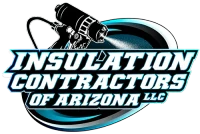Blown-In Cellulose Insulation
Sustainable, High-Performance Insulation from Recycled Materials
The Green Choice for Arizona Homes
Cellulose insulation transforms recycled paper products into high-performance thermal protection for your home. With an R-value of 3.6 per inch and excellent coverage characteristics, cellulose offers both environmental responsibility and energy efficiency.
♻️ 85% Recycled Content
Made primarily from recycled newspapers and treated with safe, fire-retardant chemicals, cellulose diverts waste from landfills while protecting your home.
What is Cellulose Insulation?
Cellulose insulation consists of small particles of recycled paper fiber that are blown into attics and wall cavities using specialized equipment. The material flows around obstacles and fills irregular spaces, creating a seamless blanket of insulation that's particularly effective in older homes with non-standard framing.
Key Advantages for Arizona Homes
Superior Heat Resistance
Higher heat capacity than fiberglass means better performance during Arizona's extreme temperature swings
Complete Coverage
Flows into every nook and cranny, eliminating gaps that rob energy efficiency
Fire Resistant
Treated with borate compounds for Class 1 fire rating and pest resistance
Sound Dampening
Dense-pack applications provide excellent acoustic insulation
Air Infiltration Control
Dense packing reduces air movement by up to 70%
Eco-Friendly
Lowest embodied energy of any insulation type
Performance in Arizona Climate
Cellulose excels in Arizona's challenging environment due to its unique properties:
🏜️ Heat Management
Cellulose has a higher specific heat capacity than other insulation types, meaning it can absorb more heat before transferring it to your living space. This "thermal mass" effect helps moderate temperature swings, keeping your home cooler during the day and releasing heat slowly at night.
💧 Moisture Handling
Unlike fiberglass, cellulose can safely absorb and release moisture without losing R-value. The borate treatment prevents mold growth, making it ideal for Arizona's monsoon season when humidity spikes temporarily.
🌬️ Settling Considerations
Properly installed cellulose settles approximately 15-20% over time. Professional installers account for this by overfilling to ensure long-term performance at specified R-values.
Installation Methods
Loose-Fill (Attics)
- Blown to desired depth using specialized equipment
- Ideal for open attic spaces
- Easy to achieve any R-value
- Can be installed over existing insulation
- Typical density: 1.5-2.2 lbs/cubic foot
Cost: $0.80-$1.20 per sq ft installed
Dense-Pack (Walls)
- Blown at high pressure into enclosed cavities
- Prevents settling and air infiltration
- Excellent for retrofit applications
- Achieves R-13 in 2x4 walls
- Density: 3.0-3.5 lbs/cubic foot
Cost: $1.50-$2.50 per sq ft installed
Wet-Spray (New Construction)
- Applied with moisture for open wall cavities
- Adheres to surfaces without netting
- No settling when properly installed
- Trimmed flush with studs
- Requires drying time before covering
Cost: $1.00-$1.80 per sq ft installed
R-Value & Coverage Guide
| Desired R-Value | Settled Thickness | Initial Install Depth | Bags per 1,000 sq ft |
|---|---|---|---|
| R-19 | 5.5" | 6.5-7" | 15-17 bags |
| R-30 | 8.5" | 10-10.5" | 24-26 bags |
| R-38 | 10.5" | 12.5-13" | 30-33 bags |
| R-49 | 13.5" | 16-16.5" | 39-42 bags |
| R-60 | 16.5" | 19.5-20" | 48-51 bags |
Cost Analysis & Energy Savings
Installation Costs
- Attic installation (R-38): $1,200-$1,800 for 1,500 sq ft
- Dense-pack walls: $2-4 per sq ft of wall area
- Whole home retrofit: $2,500-$5,500
Expected Savings
- Energy bill reduction: 20-35% annually
- Typical monthly savings: $50-$150 in cooling season
- Payback period: 4-7 years
- Added home value: $2,000-$5,000
Environmental Benefits
Safety & Treatment
Modern cellulose insulation is treated with borate compounds that provide:
- Fire Resistance: Class 1 fire rating, actually helps slow flame spread
- Pest Control: Repels insects, rodents, and other pests
- Mold Prevention: Anti-fungal properties prevent mold growth
- Non-Toxic: Safe for humans and pets after installation
Installation Process
-
Preparation & Protection
Cover all areas to be protected, install ventilation baffles, seal air leaks
-
Equipment Setup
Position blowing machine, connect hoses, load cellulose material
-
Application
Blow cellulose to specified density and depth, ensuring even coverage
-
Depth Verification
Check thickness at multiple points using depth markers
-
Cleanup & Inspection
Remove excess material, verify coverage, provide depth certificate
🔧 Maintenance & Longevity
Cellulose insulation requires minimal maintenance:
- Check depth annually and after any attic work
- Top off if settling exceeds 20% of original depth
- Inspect for roof leaks that could wet insulation
- Expected lifespan: 20-30+ years with proper installation
Common Questions About Cellulose
Is cellulose safe if it gets wet?
Cellulose can handle minor moisture exposure better than fiberglass. It will dry out without losing R-value, and the borate treatment prevents mold. However, major water damage requires removal and replacement.
Will it attract pests?
No. The borate treatment makes cellulose unappealing to insects and rodents. It's actually more pest-resistant than untreated fiberglass.
How much will it settle?
Properly installed loose-fill cellulose settles 15-20%. Professional installers compensate by installing 20% extra thickness initially.
How Cellulose Compares
| Feature | Cellulose | Fiberglass | Spray Foam |
|---|---|---|---|
| R-Value per inch | R-3.6 | R-3.1 | R-3.7 to R-6.5 |
| Eco-Friendly | 85% recycled | 20-30% recycled | No recycled content |
| Air Sealing | Good (dense-pack) | Poor | Excellent |
| Cost per sq ft | $0.80-$1.20 | $0.80-$1.50 | $1.00-$2.50 |
| Fire Resistance | Class 1 rating | Naturally resistant | Requires coating |
| Sound Dampening | Excellent | Good | Good to Excellent |
Ready for Eco-Friendly Insulation?
Join thousands of Arizona homeowners who've chosen sustainable comfort
